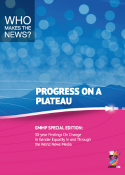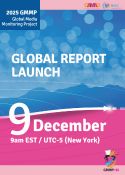19 Dec GMMP 2025 Global Report launch
Who makes the news in 2025? What progress has been made towards gender equality in and through the media over the past three decades? What critical changes should be made going forward?
Here are evidence-based answers from the GMMP 2025 Global Report 30 years after UN Member States committed to working for gender equality with the Beijing Platform for Action. Learn about findings from the 7th GMMP, which monitored over 30,000 news articles in a total of 94 countries on 6 May of this year, and hear recommendations for action to break through the inertia and drive radical change.
Featuring:
- Moderation: Albana Shala, GAMAG
- Kalliopi Mingeirou, Chief of the Ending Violence against Women and Girls Section at UN Women
- Sarah Macharia, GMMP Expert Group convenor
- Amie Joof-Cole, Inter Africa Network for Women, Media, Gender and Development (FAMEDEV); GMMP Expert Group member; GMMP West & Central Africa regional coordinator
- Cirenia Celestino Ortega, Comunicación e Información de la mujer (CIMAC–Mexico), GMMP Latin America regional coordinator
- Hilary Nicholson, GMMP Expert Group member, GMMP Caribbean regional coordinator (WMW Jamaica)
- Aimee Vega Montiel, GAMAG chair
- Sara Speicher, WACC Deputy General Secretary
Convened by WACC Global and the Global Alliance on Media and Gender (GAMAG).
9 December 2025




Sorry, the comment form is closed at this time.